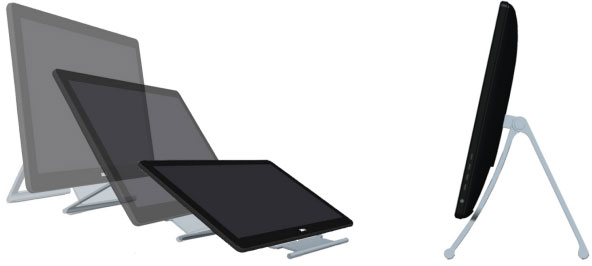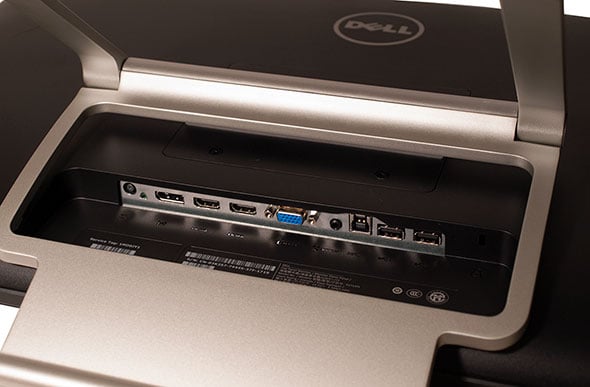Hands On with Dell's 27-inch P2714T Touch Monitor
Though it may look like a tablet, don't get any notions of carrying this thing around with you from room to room, even if you have multiple PCs throughout the home to connect it to. It's not that you can't lug the P2714T around if you're truly motivated, but at a little shy of 21 pounds, you'll quickly grow tired of carrying the display throughout your home.
Dell opted for a Plane-to-Line Switching (PLS) panel. This particular display offers a generous viewing angle of 178 degrees vertically and horizontally. It also features an 8,000,000:1 dynamic contrast ratio that's lit up by the LED backlight. It has a color depth of 16.7 million colors and a rated 83 percent color gamut.
 |
 |
Over on the other side and indented behind the panel are a pair of downstream SuperSpeed USB 3.0 ports. These are not color coded blue (they're black), but they do both operate at USB 3.0 speeds.
The last set of connectors and ports are burrowed into the backside of the panel. Getting to these ports is less than convenient, so for initial setup, we suggest laying the front of the monitor flat on a soft surface. From left to right, the P2714T sports a power cable connector, DisplayPort connector, HDMI (MHL) 1 port, HDMI (MHL) 2 port, VGA port, audio line-out port, USB upstream port, two USB 2.0 ports, and a security cable port.
Around back gives a better view of the metal and plastic stand. This thing is pretty solid and adds to the weight of the unit, and combined with the heft of the display itself, you won't have to worry about minor bumps or low rumbling earthquakes shaking the P2714T off of your desktop.
There's not a whole lot in the way of cable routing. Once you have your cables plugged into the backside, it's easiest to guide the cables through the square opening of the stand. If you have a spare zip tie laying around, you can bunch the cables together to keep your OCD tendencies from flaring up.
It's also worth noting that you can hang this panel on your wall. Using a Phillips screwdriver, you can remove the stand by taking out two screws, plus four more that hold the back cover in place. Once removed, you can attach the panel to a VESA compatible wall mounting kit with a minimum weight/load bearing capacity of 7.11kg (~15.7 pounds).

Given that Dell designed this panel for Windows 8, the stand offers flexible tilt action. It doesn't quite lay flat for a true tabletop computing experience, but it is nimble enough to go from 10 degrees to 60 degrees, depending on what you're doing. At the lower angle, some will find it easier to use touch applications, such as mapping software and some games. It's also better suited for typing on a virtual keyboard when you have the panel tilted back at an extreme angle.








